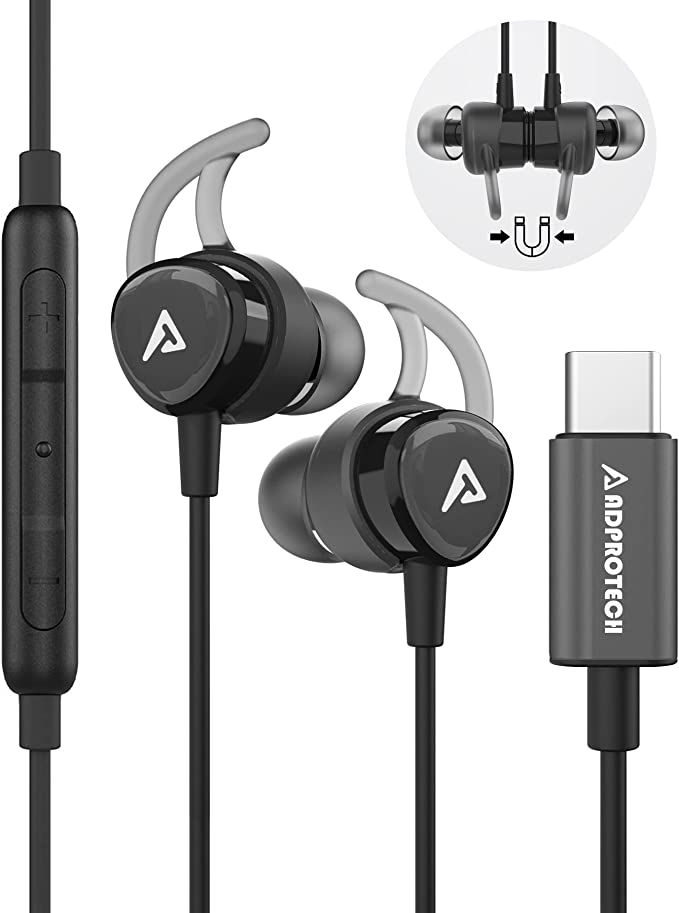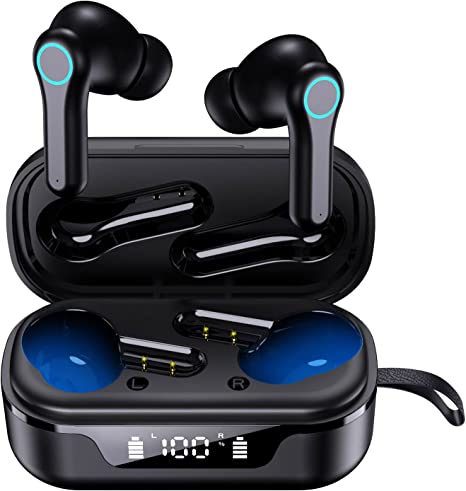The world of personal audio is in a constant, quiet revolution. For decades, the humble 3.5mm analog headphone jack was an unwavering standard, a familiar click موسيقى connecting us to our music, podcasts, and calls. But look around today – at your sleek smartphone, your slim laptop – and you’ll notice its conspicuous absence. In its place, the versatile USB-C port has risen, promising a new era of connectivity. This isn’t merely a change in shape; it’s a fundamental shift in how audio reaches our ears, a shift exemplified by devices like the ADPROTECH A0202002 USB C Headphones. Let’s not just glance at these earbuds; let’s use them as our lens to explore the fascinating science and thoughtful engineering that shape our modern sonic experiences.

The Digital Lifeline – Decoding USB-C Audio
Before we delve into the intricacies of the A0202002 itself, it’s crucial to appreciate the pathway its audio travels. The USB-C port, now gracing everything from flagship phones (like the Samsung Galaxy S20/S21/Note 10 series, Google Pixel lineup, and OnePlus devices mentioned in the A0202002’s compatibility list) to tablets (such as the iPad Pro) and computers (MacBooks and more), is far more than a simple orifice for charging. It’s a high-speed digital highway capable of carrying data, power, and, increasingly, pristine audio signals.
Traditional analog audio, like that from a 3.5mm jack, sends electrical waves that directly correspond to sound waves. Digital audio, however, is a language of ones and zeros. When headphones like the ADPROTECH A0202002 plug into a USB-C port, they are typically tapping into this stream of digital information. This means the critical task of converting that digital data back into the analog signals our ears can understand often happens much closer to, or even inside, the headphones themselves. This direct digital connection holds the promise of a cleaner signal, potentially less susceptible to the kind of interference that could plague analog pathways within a crowded smartphone chassis.

The Alchemist in Your Ear – Unveiling the Magic of the DAC
This brings us to one of the most pivotal, yet often invisible, components touted in the ADPROTECH A0202002: its “powerful DAC chip.” DAC stands for Digital-to-Analog Converter. If digital audio is a complex musical score written in a binary language, then the DAC is the master musician, the alchemist, who flawlessly translates that score into the rich, nuanced, analog symphony that resonates with our eardrums. It takes the torrent of ones and zeros streaming from your device and meticulously reconstructs them into the continuously varying electrical currents that will drive the tiny speakers within the earbuds.
But why the emphasis on a DAC within the headphones, especially now? As smartphones have shed their dedicated 3.5mm jacks, the responsibility for high-quality audio conversion has become somewhat decentralized. While some devices might have excellent internal DACs routing to their USB-C ports, others might not prioritize this, or the internal circuitry could introduce noise. By integrating a dedicated DAC, the A0202002 aims to take control of this crucial conversion process, striving for consistent “Hi-Fi stereo sound” and minimizing “current noise,” as its product description suggests. “Hi-Fi,” or High-Fidelity, is a term that’s been around since the mid-20th century, fundamentally meaning that the reproduced sound is very faithful to the original recording. A well-implemented DAC is a cornerstone of this fidelity. It works to preserve the nuances, the dynamic range (the difference between the quietest and loudest sounds), and the clarity of the original audio, ensuring that what you hear is as close as possible to what the artist intended.
Imagine settling in to listen to a complex orchestral piece or a densely layered electronic track with the A0202002. A capable DAC can help unveil subtle instrumental lines, the delicate decay of a cymbal, or the precise attack of a bass note that might otherwise be lost or muddied. It’s about transforming mere data into an evocative auditory experience. This is the silent, intricate work the DAC performs, heartbeat by digital heartbeat.

Ingenuity in Interaction – Design That Understands You
Beyond the digital heart of the A0202002, its physical design incorporates several features aimed at enhancing the everyday user experience, often leveraging simple scientific principles in clever ways.
The Subtle Pull of Convenience: Magnetic Attraction
The product description highlights the “powerful magnet on the back” of each A0202002 earbud. This isn’t a revolutionary breakthrough in physics, of course; it’s the simple, reliable force of magnetism. Yet, its application here is a prime example of user-centric design. For anyone who has ever fished a tangled Medusa of headphone wires from a pocket or bag – a near-universal frustration that could humorously be dubbed “cord contortion syndrome” – this feature is a small sigh of relief. When not in use, the earbuds can be clicked together, forming a neat loop that can hang around your neck or be coiled tidily. It’s an elegant, low-tech solution to a high-annoyance problem, demonstrating that thoughtful design doesn’t always require complex technology.
The Whisper of Wires: In-Line Controls & The Unseen Microphone
Further enhancing practicality is the “Built-In Microphone & Remote Control.” This unassuming module, typically a small casing along one of the earphone wires, is a miniature command center. Inside, tiny switches allow you to adjust volume, play or pause music, and answer or end calls, while an integrated microphone (described as an “HD microphone”) captures your voice. The convenience is undeniable: imagine jogging and receiving a call, or wanting to skip a track while your phone is tucked away. These controls, working through electrical signals sent back to the host device via the USB-C connection, offer a seamless way to interact with your audio and communication without breaking stride.
The Embrace of Sound – Ergonomics, Fit, and the Pursuit of Comfort
The claim that the ADPROTECH A0202002 is “ergonomically designed for the human ear canal” and comes with “three different sizes earbuds” touches upon a deeply important aspect of headphone design: the intimate relationship between physical form, comfort, and acoustic performance.
Our ears are wonderfully unique, with the concha (the bowl-shaped outer part) and ear canal varying significantly in size and shape from person to person. This is why a “one-size-fits-all” approach to earbuds often results in discomfort for many, or earbuds that simply refuse to stay put. The provision of multiple eartip sizes (typically small, medium, and large, made from a soft, pliable material like silicone) is a fundamental step in addressing this anatomical diversity. Finding the right fit is paramount for several reasons.
Firstly, comfort. An ill-fitting earbud can create pressure points, leading to soreness and fatigue, especially during “long periods” of use, as one might experience during a cross-country flight, an extended gaming session, or a day filled with online meetings. The A0202002’s emphasis on being “lightweight” further contributes to this goal of almost-unfelt presence.
Secondly, stability. Whether you’re commuting, working out (“running and gym exercises” are mentioned as ideal uses), or simply moving about, you want your earbuds to remain securely in place. A proper fit, often aided by the slight friction and conforming nature of the eartips, is key to this.
Thirdly, and crucially for sound quality, is the acoustic seal. When an in-ear headphone forms a good seal with your ear canal, it creates a small, closed acoustic chamber. This seal is vital for reproducing rich, full bass frequencies. If the seal is poor, bass can sound thin and weak, as the sound energy leaks out. Furthermore, a good seal provides a degree of passive noise isolation, reducing the intrusion of ambient sounds from your environment, allowing you to focus on your audio without needing to crank up the volume to potentially harmful levels. The aggregated user ratings from the source material, which indicate a 4.3 out of 5 for “Comfort,” suggest that many users find the ergonomic considerations of these earbuds effective.
Resilience for Reality – Weathering the Everyday
Life is rarely a pristine, controlled environment. This is where the ADPROTECH A0202002’s “IPX3 Waterproof” rating comes into play. The “IP” in this code stands for Ingress Protection, a standard developed by the International Electrotechnical Commission (IEC) to classify the degree of protection provided by enclosures of electrical equipment against the intrusion of foreign objects (like dust) and moisture.
The first digit after “IP” relates to solid particle protection, and an “X” in this position, as in IPX3, means it hasn’t been specifically rated for dust ingress (or the rating is not relevant to disclose for this type of product). The second digit, “3” in this case, signifies its level of moisture protection. An IPX3 rating means the equipment is protected against spraying water. Specifically, the test involves water spraying at an angle up to 60° from the vertical at 10 liters/minute with a pressure of 80-100kN/m² for at least 5 minutes.
What does this mean in practical terms for the A0202002 user? It means you don’t have to panic if you’re caught in a light drizzle while out for a walk, or if you work up a good sweat during your gym session. These earbuds are designed to handle such incidental exposure to moisture. However, it’s crucial to understand its limitations: IPX3 does not mean they are waterproof enough to be submerged in water, so swimming with them or dropping them in a puddle would be ill-advised. It’s about resilience against common, everyday moisture encounters.
The Universal Handshake – Compatibility in a Connected World
The final piece of this technological puzzle is the “Wide Compatibility” of the ADPROTECH A0202002. The product details list an array of devices, from Samsung, Google, OnePlus, and Xiaomi Android phones to Apple’s USB-C equipped iPads and MacBooks, and even HTC devices. This isn’t an accident; it’s a direct benefit of the industry’s steady coalescence around the USB-C standard.
For years, the mobile and computing landscape was a fragmented collection of proprietary and often frustratingly incompatible connectors. USB-C emerged as a powerful, unified standard designed to handle data, power, and video/audio over a single, reversible connector. This standardization means that a well-designed USB-C accessory, adhering to the common protocols, can achieve broad plug-and-play functionality across a diverse ecosystem of host devices. For the consumer, this translates to a welcome simplicity: the potential for one pair of reliable wired headphones to serve multiple devices, reducing clutter and a drawer full of dongles. While nuances in USB-C audio implementation can still occasionally arise between device manufacturers, the general trend is towards greater interoperability, which the A0202002 clearly aims to leverage.
Even the inclusion of a “potable storage bag,” as mentioned in the descriptive text of the source, is a small but thoughtful addition, acknowledging that these audio companions travel with us and deserve a measure of protection against the rigors of daily transit.
Epilogue: The Unheard Symphony of Thoughtful Engineering
As we conclude our exploration, it becomes clear that even an accessible pair of USB-C headphones like the ADPROTECH A0202002 is far more than the sum of its parts. It is a miniature symphony of digital audio processing, material science, ergonomic considerations, electromagnetic principles, and robust standardization. From the critical conversion of digital bits to analog waves by the DAC, ensuring your music retains its soul, to the simple magnetic click that saves you from wire-wrangling, and the carefully sculpted eartips that deliver both comfort and acoustic integrity, each element plays its part.
In our increasingly digital lives, it’s easy to take such technologies for granted. Yet, by pausing to understand the science and design woven into these everyday objects, we can cultivate a deeper appreciation for the ingenuity that works, often silently, to enrich our experiences. The journey of sound, from a distant server to the intricate pathways of your inner ear, is a testament to human innovation, and the ADPROTECH A0202002 offers a tangible, accessible stop along that remarkable voyage. It reminds us that good design and smart technology, even in small packages, can make our daily soundtrack just a little bit sweeter.




